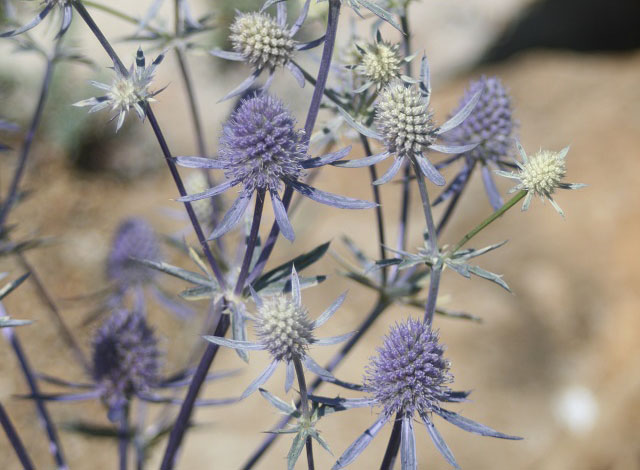
Submitted by Beth Willis, trials coordinator for the UT Gardens, Knoxville
If your garden is crying out for something a little different – you owe it to yourself to check out sea holly. Not only is it an architecturally striking plant, it thrives in conditions often considered challenging. Eryngium, commonly known as sea holly or eryngo, can refer to several closely related species in the Apiaceae (carrot) family. Plants form numerous blooms of tight umbels with spiny bracts surrounding each bloom. Each bloom and even the stems can display a blue or violet color. Most varieties grow to between 2 and 3 feet tall from a basal rosette.
Sea holly prefers full sun and a well-drained location and does best in poor soils. When grown in rich soils or part shade, plants tend to sprawl if not staked. Most cultivars are hardy to zone 5, and once established are very drought tolerant. Site the plant carefully before planting, as it does not transplant well due to its large taproot. Most of the varieties will self-seed, so remove seed heads if you don’t want volunteers.
Sea holly can also be propagated by careful division or by root cuttings.Sea holly can be dramatic as a single specimen or in a mass planting, and it can fit into every garden style from formal gardens to wildflower collections to rock gardens. It is very attractive to butterflies. If the stalks and spent blooms are left on the plant, it provides winter interest in the garden. Stalks can also be removed and used either fresh or dried in bouquets and other arrangements.
Sea holly is not susceptible to any significant pest or disease problems, and it has no major maintenance issues. Once planted and established, it is remarkably carefree in the garden.
Some of the varieties available on the market include:
- E. planum ‘Blue Glitter’ – starts easily from seed, and can bloom first year from seed.
- E. zabelii ‘Big Blue’ – boasts some of the largest blooms of any variety – up to 4 inches wide.
- E. planum ‘Jade Frost’ – variegated foliage of pink, cream and green make this a personal favorite.
- E. giganteum (Miss Wilmott’s Ghost) – silvery blue blooms on plants that reach up to 6 feet in height.
Beth Willis is the trials coordinator for the UT Gardens, Knoxville. Designated as the official botanical garden for the State of Tennessee, the UT Gardens include plant collections located in Knoxville, Jackson and Crossville. As part of the University of Tennessee Institute of Agriculture, their mission is to foster appreciation, education and stewardship of plants through garden displays, educational programs and research trials. The gardens are open during all seasons and free to the public. For more information see http://utgardens.tennessee.edu.
Contact:
Beth Willis, UT Gardens, Knoxville